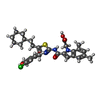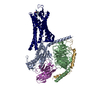+Search query
-Structure paper
| Title | Structural insights into human brain-gut peptide cholecystokinin receptors. |
|---|---|
| Journal, issue, pages | Cell Discov, Vol. 8, Issue 1, Page 55, Year 2022 |
| Publish date | Jun 7, 2022 |
 Authors Authors | Yu Ding / Huibing Zhang / Yu-Ying Liao / Li-Nan Chen / Su-Yu Ji / Jiao Qin / Chunyou Mao / Dan-Dan Shen / Lin Lin / Hao Wang / Yan Zhang / Xiao-Ming Li /  |
| PubMed Abstract | The intestinal hormone and neuromodulator cholecystokinin (CCK) receptors CCK1R and CCK2R act as a signaling hub in brain-gut axis, mediating digestion, emotion, and memory regulation. CCK receptors ...The intestinal hormone and neuromodulator cholecystokinin (CCK) receptors CCK1R and CCK2R act as a signaling hub in brain-gut axis, mediating digestion, emotion, and memory regulation. CCK receptors exhibit distinct preferences for ligands in different posttranslational modification (PTM) states. CCK1R couples to G and G, whereas CCK2R primarily couples to G. Here we report the cryo-electron microscopy (cryo-EM) structures of CCK1R-G signaling complexes liganded either by sulfated cholecystokinin octapeptide (CCK-8) or a CCK1R-selective small-molecule SR146131, and CCK2R-G complexes stabilized by either sulfated CCK-8 or a CCK2R-selective ligand gastrin-17. Our structures reveal a location-conserved yet charge-distinct pocket discriminating the effects of ligand PTM states on receptor subtype preference, the unique pocket topology underlying selectivity of SR146131 and gastrin-17, the conformational changes in receptor activation, and key residues contributing to G protein subtype specificity, providing multiple structural templates for drug design targeting the brain-gut axis. |
 External links External links |  Cell Discov / Cell Discov /  PubMed:35672283 / PubMed:35672283 /  PubMed Central PubMed Central |
| Methods | EM (single particle) |
| Resolution | 3.0 - 3.2 Å |
| Structure data | EMDB-33359, PDB-7xou: EMDB-33360, PDB-7xov: EMDB-33361, PDB-7xow: EMDB-35297, PDB-8ia7: |
| Chemicals |  ChemComp-IA1:  ChemComp-HOH: |
| Source |
|
 Keywords Keywords |  NEUROPEPTIDE / brain gut peptide receptor Class A G-protein-coupled receptor NEUROPEPTIDE / brain gut peptide receptor Class A G-protein-coupled receptor |
 Movie
Movie Controller
Controller Structure viewers
Structure viewers About Yorodumi Papers
About Yorodumi Papers













